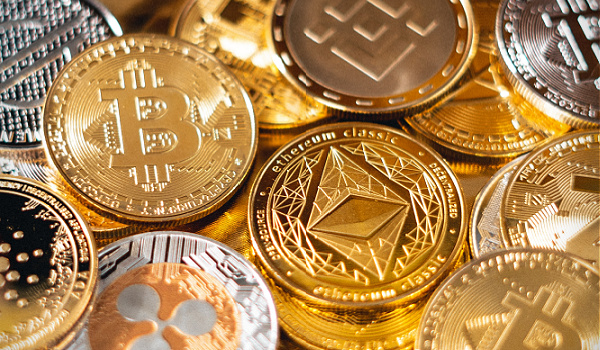By Sarson Funds, Inc.
Today, there is an ongoing scramble among global powers to understand cryptocurrencies and use them—and their underlying blockchain and distributed ledger technologies—for their own benefit.

In the right conditions, crypto assets and technology can become tools to centralize or decentralize societies, which is creating an uneasy relationship between many governments and crypto, according to John Sarson, CEO of Sarson Funds, a crypto asset manager and education provider for the wealth management industries. At the same time, people are gravitating towards digital assets and gradually populating a developing “metaverse” that is real, but not physical, potentially planting seeds for change driven from the bottom up.
What does this mean for the future?
Struggling With Change
In part one, we discussed how Russia and China are respectively exploring digital assets as a potential means to destabilize the world or exert control from the top-down onto their population. Western policymakers are struggling to understand digital assets.
In the emerging world, there is a divergence in stances on crypto, with some countries like India moving to regulate and ban certain uses of the currency, many Latin American countries exploring them as a solution for their under-banked populations, and many Africans using crypto as stability against uncontrolled and unpredictable inflation in their local currencies.
These divisions are defined by a physical world incised by political and geographical boundaries, which lead to differences in law, policy, regulation, culture and language.
But the metaverse is coming, said Sarson. It’s actually already here, but it’s far from fully built.
Getting Meta
The metaverse is a convergence of next-generation high-speed internet, AI, virtual reality and digital assets to create an immersive, all-virtual world not defined by any physical boundaries, enabling new immersive interactions between people and content. The best analogy we have today is in online massively multiplayer gaming, which has over time become incredibly realistic and drawn millions of participants who are creating their own communities and cultures.
The people responsible for building the metaverse today are the same visionaries who built the most successful social media companies in the Western world. Jack Dorsey, founder of Twitter and CEO of digital payments company Square, has made clear that the future of payments will involve the metaverse and cryptocurrency.
Mark Zuckerberg, CEO of Meta (formerly Facebook), has been investing in the technologies converging to create the metaverse for a number of years. Zuckerberg’s vision is that most of the real world will move online into a fully formed, all-encompassing digital world with virtual communities, networks and economies.
The metaverse’s communities and economies would transcend political borders, geography and national identities, said Sarson.
“Individuals that today identify with their hometown or state or nation or race may one day identify primarily with metaverse-based decentralized autonomous organizations (DAOs) that have their own foreign policies,” he said. “Such a transition would require us to re-think geopolitical affairs from the ground up.”
Opportunity or Challenge?
While policymakers struggle to understand the meaning of this impending change, Wall Street is embracing it. Sarson said that bankers have warmed to the idea of virtual worlds and economies, with Jeffries and Company saying it will impact how humans live more than anything they have ever seen—even the internet. Jeffries went on to say that investors need to think about the metaverse in the same way that investors in the 90s thought about the internet.
Morgan Stanley, too, has become a champion of the metaverse, said Sarson. In a note in November 2021, the bank’s analysts identified the internet as the next-big thing in investing.
Cryptocurrencies, with their ability to transcend borders and boundaries, are likely to be the money of choice in the metaverse, Sarson said.
“The real world isn’t going to be subsumed by the metaverse; instead, the metaverse will become a new frontier for human action,” he said. “A central part of the metaverse, just like our offline world, is going to be finance. There will be buying and selling, asset investing, and credit extension. The difference is that the financial system of the metaverse will work in the real world, but the old financial system will not work for the metaverse.”
Cash, because it is a tangible object, cannot exist in the metaverse, but blockchains and their coins will, said Sarson. Cryptocurrency, on the other hand, offers a new foundation for all of finance, commerce and exchange.
Blockchain All The Things
Stocks representing fractional ownership in companies will eventually be replaced by ownership that is represented by tokens on a blockchain. The deeds and titles for real estate will come to be recorded on a blockchain, and blockchain will offer new opportunities for fractional ownership in that asset class as well.
Blockchain technology will also expand the ways in which people participate in different types of investments,” he said. “Take, for example, a real estate investment trust or private placements. Today there are term sheets, subscription documents, and lots of other hoops people must jump through—very expensive hoops. There’s aren’t many ways people can invest in art or other collectables, either Mostly people can either buy the object d’art or become part of a purchase syndicate. Blockchain technology supports fractionalized owner- ship, and when you can fractionalize the cost of ownership, you can expand your investor base.”
As blockchain eliminates intermediaries, costs, inefficiencies and errors, it has the potential to unlock a tremendous amount of value, said Sarson.
“The challenge is that the legacy oxen will get scored,” he said. “Traditional stakeholders are going to fight this because it’s unknown to them. Just as the internet has leveled a lot of the traditional commercial institutions, blockchain is going to level much of the existing financial architecture where a lot of money is made.”
Sarson notes that the adoption of crypto, thus far, has occurred “exponentially” faster than the adoption of the internet, growing from 5 million users in 2016 to 106 million users in July 2021. The number of people using cryptocurrencies today is now the same as the number of internet users in 1997.
Even if the growth rate levels off and the current rate of growth continues for the next five years, the cryptocurrency industry would boast one billion users in 2027, said Sarson.
Are we ready for that future?

To answer that question, we first need to understand how major global actors are approaching the cryptocurrency space, said Jahon Jamali, CMO and co-founder of Sarson Funds, a crypto education provider and asset manager for wealth managers.
“The growth in the cryptocurrency users is actually outpacing the spread of the internet,” he said. ”If the current growth rate continues over the next five years, the cryptocurrency industry would boast a billion users—comparable to the spread of the internet.”
Different global actors are taking different approaches towards understanding, adopting and embracing crypto, said Sarson. Among major global actors, there is a “mad scramble” to grasp the crypto universe and leverage it for their own benefit.
This scramble has led to a variety of approaches among first-, second- and third-world powers. Russia and China, for example, see crypto as a way to circumvent the dollar, said Sarson, and are building their own stockpiles of bitcoin.
Russia
Russia has enabled some state-run commercial actors, like the Russian Institute for Internet Research, to participate in cryptocurrencies. The Institute, said Jamali, is really a think-tank associated with a bogus university that is really a front for the GRU, the Russian military intelligence agency.
“The institute is behind a lot of information about bitcoin because the Russians like to weaponize information,” he said. “There is a meme of the devil arm-wrestling Jesus, that is their work. They also have deployed criminal hackers to utilize crypto as a means of transferring money via ransomware. Basically, they are testing its utility for their purposes.”
China
China, on the other hand, has banned bitcoin 18 different times since 2014, said Sarson, yet owns the second largest bitcoin stockpile in the world.
The contradiction, which Jamali says causes “confusion” among the Chinese population, coincides with efforts to roll out the digital yuan.
“In effect, they’re hedging their bets,” said Jamali. “They know that the digital asset movement is for real and that it is the future, so they are hedging the bitcoin bet with the roll out of their own digital yuan,” which will be a centralized currency that provides the Chinese Communist Party real-time knowledge of individual transactions. “The Party will be able to reward or punish people by adding or removing currency from their wallets.”
The Party will also be able to restrict what people buy on an individual level, said Jamali, thus deploying blockchain-based currency as a tool of control.
The West
In Western countries, stakeholders believe “the traditional markets in which they hold equity are being threatened,” said Jamali. Thus, they slow the regulatory process down. Congress still doesn’t understand how bitcoin or blockchain work, so they aren’t rushing to address them.
“The crypto section of the recently passed infrastructure legislation demonstrates this fact,” said Jamali. “When people in Congress write provisions that set forth how decentralized exchanges are to report transactions, it indicates they lack any understanding that there is no realistic capability to do that.”
At the same time, agencies like the Federal Reserve and the Treasury are working to develop their own digital dollar, which would offer the government the ability to put money into people’s pockets during an economic downturn and even put requirements on how those dollars can be spent.
Unfortunately, a digital dollar would also create some of the same concerns about surveillance and control that have recently surfaced in China, said Sarson.
“It will also create a temptation to create more dollars digitally, which would stoke inflationary fires,” he said. “It will, in fact, increase the efficiency of how dollars can be distributed.”
Take the Covid-19 stimulus as an example—payments were wired into the bank accounts of some, while others received paper checks sometimes months after the money was appropriated, said Jamali. “Democrats see this as a tool to deliver government aid quicker. Republicans see it as a way to reduce layers of bureaucracy.”
Emerging Markets
The emerging world can be divided roughly into two camps. In Latin America, bitcoin is seen as a savings mechanism that their large unbanked population can use.
El-Salvador is the first major Latin American experiment in digital assets, where the government has recognized bitcoin as legal tender. Other countries including Paraguay and Panama, are considering adopting the bitcoin standard.
Africa, on the other hand, see bitcoin as potential stability after a history of uncontrollable inflation. Cryptocurrencies are also allowing many Africans to send money internationally and domestically in an efficient manner for the first time.
India has decided to ban the use of bitcoin and many other cryptocurrencies as legal tender. Crypto trading will not be banned, but instead regulated similarly to stocks.
“In the global race, people need to understand Bitcoin is more than a thing. You can’t ban it or try to put any clampdown on it,” said Jamali. “The question in China and India is who is going to want it, because if people want it, they are going to get it. The infrastructure can move to the US or elsewhere, but anyone can still use a VPN. You can’t kill an idea. And this is what it’s become now: it’s alive. It’s not going away.”
A State-Led Approach to Regulation
For Jamali’s part, he advocates a bottom-up approach to regulating digital assets in lieu of a national top-down approach.
Such an approach would meet the moment, as China’s crackdown on bitcoin mining has driven many major firms to states like Texas and Wyoming, where energy companies saw the merit in monetizing otherwise unused energy.
“In the United States, we have a carbon tax credit that can help promote the use of renewable energy. This means the United States has an opportunity to house the blockchain infrastructure,” he said. “This is a distinct opportunity for the country.”








